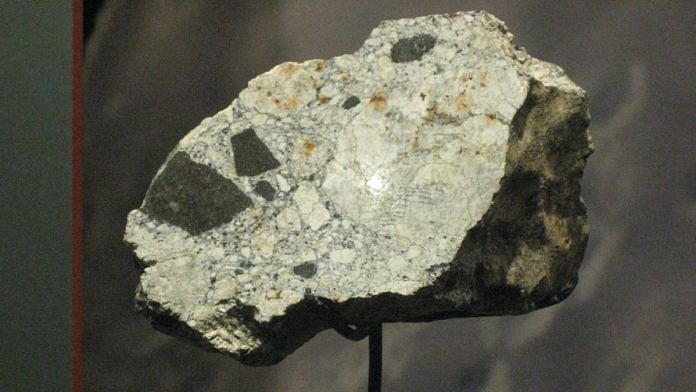New Delhi: On 17 August last year, a woman in Ravel village in Gujarat was cleaning her porch when a piece of rock came crashing down next to her. It damaged the tiles of her porch and created a small crater. Not far away, villagers of Rantila witnessed a similar piece of rock hit a branch of a neem tree and shatter into pieces.
A team of researchers from the Physical Research Laboratory (PRL), Ahmedabad have now found that the rock, which emitted a pungent smell on its fall, was a rare kind of meteorite that had only been seen in India once —170 years ago.
“Our preliminary description and study suggest that the meteorite is a rare, unique specimen of aubrite,” said the researchers, after analysing the fragments and pieces recovered from the spot.
According to the study, published in the journal Current Science last month, the fragments mainly contained a mineral known as enstatite, characteristics of which were similar to what is thought to be seen on the surface of Mercury.
“This rare specimen of meteorite not only improves the existing meteoritic database, but will be important for understanding the planetary processes in future,” wrote the researchers.
Also Read: Did space sow seeds of life on Earth? Japan scientists find building blocks of DNA in meteorites
What are aubrites?
Aubrites are a type of achondritic (or achondrite) stony meteorite, which means they do not contain chondrules, or small spherical grains of mineral that are common in other types of meteorites. They are named after the Aubres meteorite, which fell in France in 1836 and was the first known example of this type of meteorite.
According to the research team, while the Indian subcontinent witnessed an exceptional record of meteorite falls, this is only the second reported aubrite to fall in India, after the Bustee fall in 1852 in Gorakhpur, Uttar Pradesh.
Aubrites originate from an extremely reduced differentiated parent body in our solar system, said the researchers.
Analysing the fragments
Last year’s meteorite fall was witnessed by villagers in Rantila and Ravel, in Gujarat’s Diyodar taluka, Banaskantha district, around 7:30 pm on 17 August. In Rantila, they reportedly heard a thunderous sound — like the passing of a jet plane — and saw a large piece of the meteorite hit a neem tree branch and shatter into several fragments on impact. At the same time, the woman in Ravel also witnessed the “rock” crashing in on her porch.
Several fragments of the meteorite were found scattered in the fields in Rantila, which the villagers collected. The largest fragment weighed around 200 grams and measured 12 cm × 6 cm × 4 cm in size, according to the study.
The larger pieces, including the one that fell in the woman’s house, were handed over to the local tehsildar’s office in Diyodar by the villagers. Later that month, the research team visited the area and collected two large fragments, weighing about 200 and 20 grams.
The team also did a thorough search to look for more meteorite fragments in the vicinity.
After interviewing several eyewitnesses and plotting the fall locations on a map, the team was able to recreate the trajectory of the meteorite. The researchers postulate that there could be more fragments of the meteorite in between and away from these villages along the trajectory.
Specimens recovered from both villages appeared to be similar in nature, suggesting that they were likely part of a single mass before breaking into fragments during its passage through the Earth’s atmosphere.
The fragments were fragile, and the inner material was brittle. A light brown fusion crust — just about 0.5 millimetre thick — has been partly preserved over small areas in both fragments, indicating that they are part of a larger meteorite chunk.
The meteorite consisted of large pyroxene grains — some measuring up to 2.0 cm — in the form of bright white translucent crystals.
(Edited by Geethalakshmi Ramanathan)
Also Read: Rare 7kg meteorite found in Antarctica, one of five new space rocks discovered



